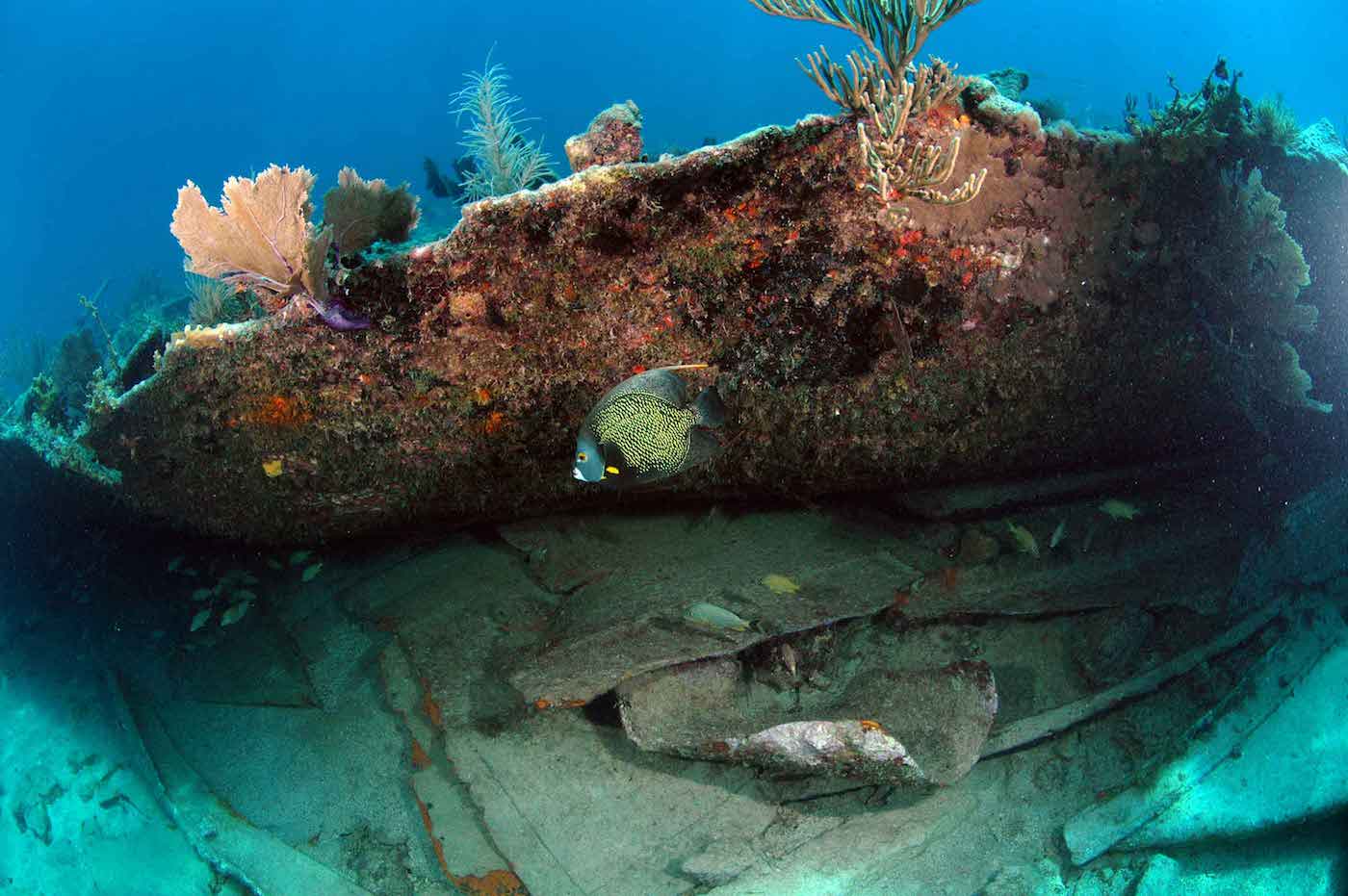While there are many great places to dive in around the world, one of the best is located on Florida’s southern tip of Florida .The quality and variety of diving in the Florida Keys, which are home to the third-largest barrier reef in the world, is one of the main draws for tourists visiting the area.
Known as the world’s diving capital, there are countless opportunities for divers with any level of certification. In this blog, we will be exploring the top 10 best dive sites that Florida Keys has to offer!
Molasses Reef – Key Largo

Divers frequent this reef more than any other in the Keys. Divers of all skill levels can explore the depths of this reef. Divers can experience a wide variety of things at depths ranging from five to ninety feet. The water surrounding the reef is crystal clear and quite visible. With average depths of around 30 feet, you can have long dives on this reef. Just a quick move to another anchor ball allows you to experience a whole new set of sea life in close proximity.
Along with the stunningly vibrant coral on the reef itself, divers can anticipate seeing rays, turtles, nurse and reef sharks, parrotfish, and many other species.
Level of Expertise Required: All levels
Marine animals you can encounter here: Turtles, Sting rays, moray eels, sharks, spotted eagle rays, and various types of tropical fish live at Molasses Reef.
Key Feature: Molasses Reef has an iconic light on the middle of the reef and has over 30 places to moor and SCUBA dive/snorkel. The south end of the reef often has a little current and is also the home of the larger pelagic species.
USS Spiegel Grove (Key Largo)

510 feet long, the U.S. in June 2002 intentionally sank a Navy ship. The USS Spiegel Grove was flipped over so that it stood upright in the hurricane’s wake, changing its position on the bottom due to Hurricane Dennis. This dive site has developed into a significant man-made reef ecosystem.
One of the largest artificial reef systems in the US, you’ll want to be sure that you are armed with an underwater camera when you visit this site.
Level of Expertise Required: All levels
Marine animals you can encounter here: You will have a good chance of seeing Parrotfish, Sting Rays, Moray Eels, Trigger Fish, Barracuda,Grouper, Reef Sharks, Permit ,Yellowtail, Snapper, Fire Coral and more!
Key Feature: The Spiegel Grove is so wide that on many days, the view of the superstructure will fade into a green-blue abyss.
Sombrero Reef – Marathon Keys

One of the shallow dive sites on the whole island is Sombrero Key Lighthouse, which reaches 142 feet. It is composed of several species of coral and is located between thirty and thirty-five feet below the surface of the ocean. There are bright little tropical fish species among the corals, which include brain, finger, lettuce, and gorgonians.
Level of Expertise Required: All levels, ideal for beginners
Marine animals you can encounter here: You’ll see typical Caribbean life like nurse and reef sharks, possible eagle rays, turtles, stingrays, and lots of fish: snapper, angelfish, grunts, parrotfish, and grouper.
Key Feature: Another attraction here in Sombrero Reef is “The Arch” – a coral bridge, which creates a large swim-through to dive in.
Pickles Reef

Pickles Reef is a great Florida Keys snorkeling or shallow dive site. Not only can someone enjoy the plentiful marine flora and fauna this area provides, there’s some history to examine and explore wreck diving.
Remnants of a civil war wreck are here. Its once heavy cargo of barrels filled with cement have turned into concrete tubes.
Since this Florida Keys dive site is further out from Key Largo, it’s not frequented as often. The area is less busy, the fish are more numerous, and in the case of the pillar coral, quite massive. At the north end you’ll be surprised to find large colonies of these stony coral monsters towering upwards of 10 feet.
Level of Expertise Required: All levels
Marine animals you can encounter here: You’ll see lots of moray eels here including not only green but spotted and golden tail morays as well.
Key Feature: Pickles Reef is not as well known as the other, larger reefs nearby but, due to its relatively shallow depth, it is an ideal site for both divers and snorkelers.
USS Wilkes Barre – Key West
Lying over 150 feet below, this 1942 built Cleaveland Class Cruiser was once 608 feet long. It is the largest shipwreck in the Florida Keys and is quite an adventure; the top sections of the ship can be reached at 145 feet of water, while lower sections are 250 feet deep. Named after the town of Wilkes-Barre in Pennsylvania, the ship received four battle stars for its role in the war before being placed in reserve. During the early 1970s, the ship sank after being exposed to the underwater testing of explosives. Today it serves as an enormous artificial reef for the adventurous diver.
Level of Expertise Required: Advanced
Marine animals you can encounter here: Divers also are treated to an assortment of sharks, sperm whales, snapper, barracuda, manta rays, sailfish, grouper, mahi mahi, amberjack, and many other species of ocean life.
Key Feature: A variety of military remnants and operating equipment can be seen along the decks and within the rooms of the superstructure, including gun turrets, anti-aircraft gun stations, radar monitors and gun emplacements.
The Benwood

A terrible series of circumstances in 1942 resulted in the loss of an English-built cargo vessel to the sea. The Benwood is situated on a level stretch of beach. Its bow points 45 feet offshore, while its broken stern is located at a depth of 25 feet. The hull extends to its full length, with parts of the outer wall still visible, and the bow is the most preserved aspect of the wreck.
There are several “nooks and crannies” in this fantastic exposed wreck where you can stick your head in and see what lurks beneath the surface. There’s fish, lobster, eels, and shrimp to be found.
Level of Expertise Required: All levels
Marine animals you can encounter here: Surrounded by colorful living coral reef and is now home to many moray eels, lobsters, turtles and thousands of bright reef fishes.
Key Feature: Today the Benwood is the most popular night time diving site in the Florida Keys. Night divers have the opportunity to see corals feeding at night, a spectacular show for all.
French Reef
The well-known reef is a breathtaking location with an abundance of swim-throughs, ledges, tunnels, and caverns. Moray eels and glassy sweepers are frequently seen in and near these caves. The stunning limestone cliffs at this dive site are another reason for its fame. Elkhorn coral, which reaches the water’s surface, is a stunning golden brown color that covers the shallow sections of the reef.
Level of Expertise Required: All levels
Marine animals you can encounter here: Eagle Rays and even Manta Rays have been sighted out here as well as Loggerhead turtles, Hammerhead and Reef Sharks.
Key Feature: French Reef is known for its many caves and arches, easily accessible even to novice divers. At the south end is Hourglass Cave, named for its shape.
USS Duane and Bibb

These twin cutters lie a mile south of Molasses Reef. Each ship is 327 feet long and they lie 130 feet below the water. The World War II ships now serve as artificial reefs covered with coral and are home to large sea creatures. This wreck dive experiences a moderate to heavy current more often than not due to its placement near the gulf stream. Laying on her Starboard side, most of this wreck sits below 100 feet with very little relief from any currents at shallower depths. Due to its positioning, it’s one of the deepest wrecks in the area making it an Advanced Dive.
Level of Expertise Required: Experience with wreck dives required
Marine animals you can encounter here: Divers can expect to see Whale Sharks, Giant Sea Turtles, and Barracudas while exploring the wreck.
Key Feature: The upright nature of this vessel allows divers to find shelter from the currents and provides a safe haven for Manta Rays, Bull Sharks, Goliath Grouper, Barracudas, Cobia and more.
Coffins Patch
Even though the dive site’s name may scare off some divers, the treasures that the stories about it carry will entice those same divers to return! According to legend, a Spanish ship that struck the reef scattered gold and silver coins all over the Patch’s floor. With six distinct reefs comprising this site, there’s much to explore.
Divers come to this area to see these reefs up close and personal, to be sure. They also come to this area in hopes of spotting some bits and pieces of treasure that may have been left behind and undiscovered until now.
Level of Expertise Required: All levels
Marine animals you can encounter here: Tangs, jacks, stingrays, nurse sharks, grouper, lobster, butterflyfish, and the curious moray all call Coffins Patch home.
Key Feature: The overall area is composed of 6 different reefs, each sporting a predominantly different coral. Out of all the coral reefs that make up this dive site, the “Stake” is the easiest to identify. Jutting out of its oval shape is an iron pole, hence its name.
Christ of the Abyss – Key Largo

Situated 25 feet below the surface, this 9-foot bronze monument was gifted to the Underwater Society of America by renowned Italian dive equipment producer and inventor Egidi Cressi. Its limbs extending toward the surface as it stands in the ocean’s blue waters provides for amazing photographs. This stunning figure has witnessed multiple scuba marriages and is accompanied by a variety of marine species.
Level of Expertise Required: All levels
Marine animals you can encounter here: Large Spotted Eagle Rays and Southern Stingrays are often sighted here.
Key Feature: Submerged at 25 feet, the Christ of the Abyss 9-ft tall bronze statue is the only one of its kind in the U.S. and one of three worldwide.
Best Time to Dive:
The Florida Keys are an excellent place for year-round diving since the water is consistently an inviting warm temperature. Water temperatures in the spring range from 75° to 79°. Although there isn’t much wind to worry about, the weather causes relatively unstable waters.
The most popular season to go diving is during the summer. The calm waters range in temperature from 83°F to 87°F.
Although diving in the fall and winter can be amazing, you should exercise caution when diving from August to mid-November, which is hurricane season. Although the weather is typically a little rougher at this time of year, the water’s temperature is still generally between 70°F and 83°F.
It should come as no surprise that the Florida Keys is the dive capital of the world since it has plenty to offer divers of all skill levels. There are many amazing diving locations in the area that would take a lifetime to explore. Any diver ought to consider exploring these stunning dive sites of Florida Keys at some point, as they have some of the best diving in the United States.
Do you have a favorite place for diving in the Keys? Share your experience with us in the comments below!

